Nathalie Lazaric and Alain Raybaut (2004)
Knowledge Creation Facing Hierarchy: the Dynamics of groups inside the Firm
Journal of Artificial Societies and Social Simulation
vol. 7, no. 2
<https://www.jasss.org/7/2/3.html>
To cite articles published in the Journal of Artificial Societies and Social Simulation, reference the above information and include paragraph numbers if necessary
Received: 07-Feb-2004 Accepted: 07-Feb-2004 Published: 31-Mar-2004
 Abstract
Abstract| ei (t) = {xi (t)}ai, i = 1, …, n, | (0.1) |
where 0 < ai ≤ 1.

|
(0.2) |
where 
 the knowledge component in each group. It is assumed that localized knowledge creation is stochastic and modelled in each group by a Poisson process with an arrival rate, λi = μi + ξ i, i = 1, …, n.
the knowledge component in each group. It is assumed that localized knowledge creation is stochastic and modelled in each group by a Poisson process with an arrival rate, λi = μi + ξ i, i = 1, …, n.

|
(0.3) |
 , and the total number of interactions by
, and the total number of interactions by  . For i = 1, …, n we have:
. For i = 1, …, n we have:

|
(0.4) |
|
|
| Figure 1. |
 , finally comes down to:
, finally comes down to:

|
(0.5) |
where ei(t) refers to the effort of group i at time t.
| Q(t) = B(t){E(t)}β | (1.1) |
with  , and 0 < β ≤ 1. The term B(t) refers to a global learning by doing mechanism in the firm that captures the accumulation of knowledge within the same. Global learning is modelled by the combination of the activation levels of the different practices determined by knowledge creation and hierarchy pressure in each group (see below) at time t. We have:
, and 0 < β ≤ 1. The term B(t) refers to a global learning by doing mechanism in the firm that captures the accumulation of knowledge within the same. Global learning is modelled by the combination of the activation levels of the different practices determined by knowledge creation and hierarchy pressure in each group (see below) at time t. We have:

|
(1.2) |
where Ψ is a positive, continuous, concave function.
| π( t) = pQ(t) - C(E(t)) | (1.3) |
where p refers to the exogenous market price of the production and C(E(t)) stands for a cost function, with C > 0, C' > 0, C'' > 0 with E(t) > 0. This cost function captures the direct cost of labour and the indirect costs produced by the incentive policies implemented by management. Indeed, the role played by the motivational dimension is crucial in explaining the ability of each group to promote its practices (Lazaric and Denis 2001). Motivation relates first to salary policy and secondly to the control implemented by the hierarchy in order to increase individual and collective skills in the firm.
| c(t)= Φ [ r(t)- r* (t)] | (1.4) |
(1.4) where, Φ is an increasing function of r(t)- r* (t), such that,

and
 .
.
This function is shaped as follows:
|
|
| Figure 2. |
That is to say, the owner's vision of the environment, which results in earning requirements, may induce the hierarchy to make a restrictive choice in the exploitation of idiosyncratic practices or may lead to some development and exploration of practices if the hierarchy chooses to fine tune its human resource policy.
 and the pressure of hierarchy
Hi(t) defined above. From this standpoint, we consider the following system of differential equations:
and the pressure of hierarchy
Hi(t) defined above. From this standpoint, we consider the following system of differential equations:

|
(1.5) |
with i = 1,… n. The n parameters δi, with 0 < δi < 1, refer to the exogenous obsolescence rate of each practice. The parameters σ and (1 - σ), with 0 < σ ≤ 1, stand for the respective weights of the pressure of hierarchy and of knowledge creation in the dynamics.
.gif)
|
| Figure 3.1a. Levels of activation of practices t = 0 to 2 |
.gif)
|
| Figure 3.1b. Levels of activation of practices t=2 to 40 |
.gif)
|
| Figure 3.1c. Growth rates of activation levels of practices |
.gif)
|
| Figure 3.1d. Action of the hierarchy (a positive (negative) sign means that hierarchy promotes (brings down) the practices of group i) |
.gif)
|
| Figure 3.1e. Localized learning |
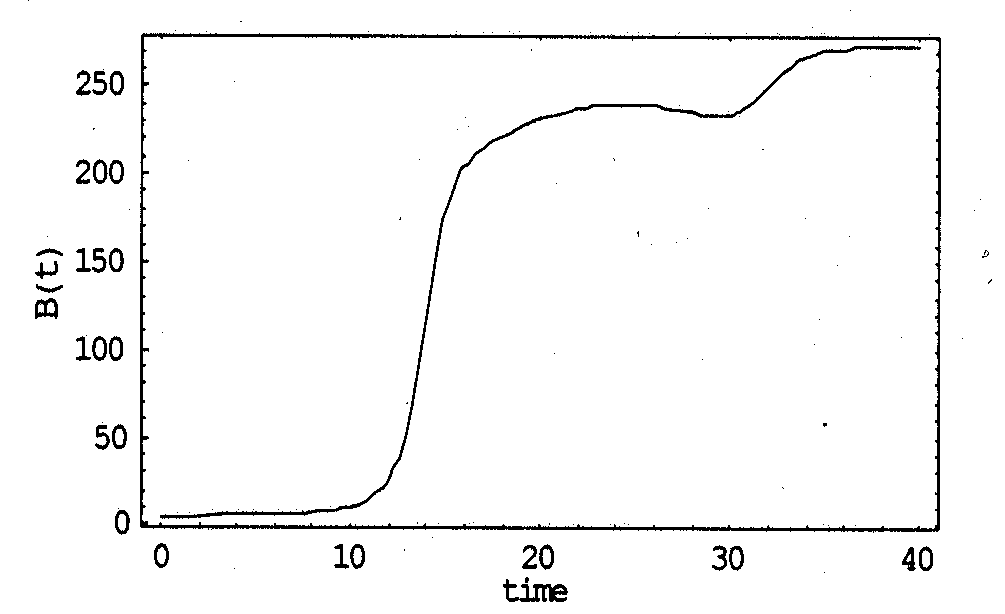
|
| Figure 3.1f. Global learning |
.gif)
|
| Figure 3.1g. Profits |
.gif)
|
| Figure 3.2a. Levels of activation of practices t = 0 to 2 |
.gif)
|
| Figure 3.2b. Levels of activation of practices t=2 to 40 |
.gif)
|
| Figure 3.2c. Growth rates of activation levels of practices |
.gif)
|
| Figure 3.2d. Action of the hierarchy (a positive (negative) sign means that hierarchy promotes (brings down) the practices of group i) |
.gif)
|
| Figure 3.2e. Localized learning |
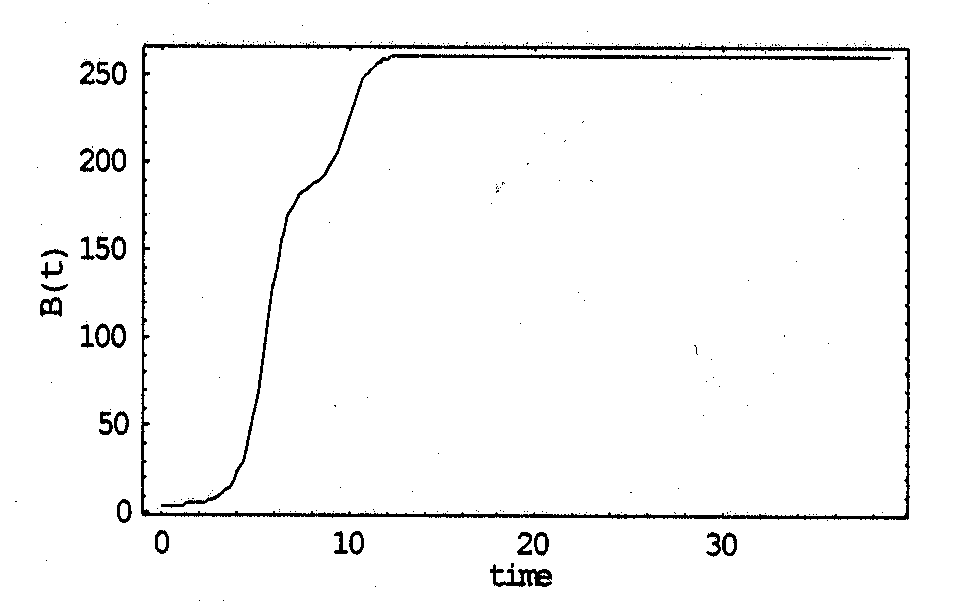
|
| Figure 3.2f. Global learning |
.gif)
|
| Figure 3.2g. Profits |
.gif)
|
| Figure 3.3a. Levels of activation of practices t = 0 to 2 |
.gif)
|
| Figure 3.3b. Levels of activation of practices t=2 to 40 |
.gif)
|
| Figure 3.3c. Growth rates of activation levels of practices |
.gif)
|
| Figure 3.3d. Action of the hierarchy (a positive (negative) sign means that hierarchy promotes (brings down) the practices of group i) |
.gif)
|
| Figure 3.3e. Localized learning |
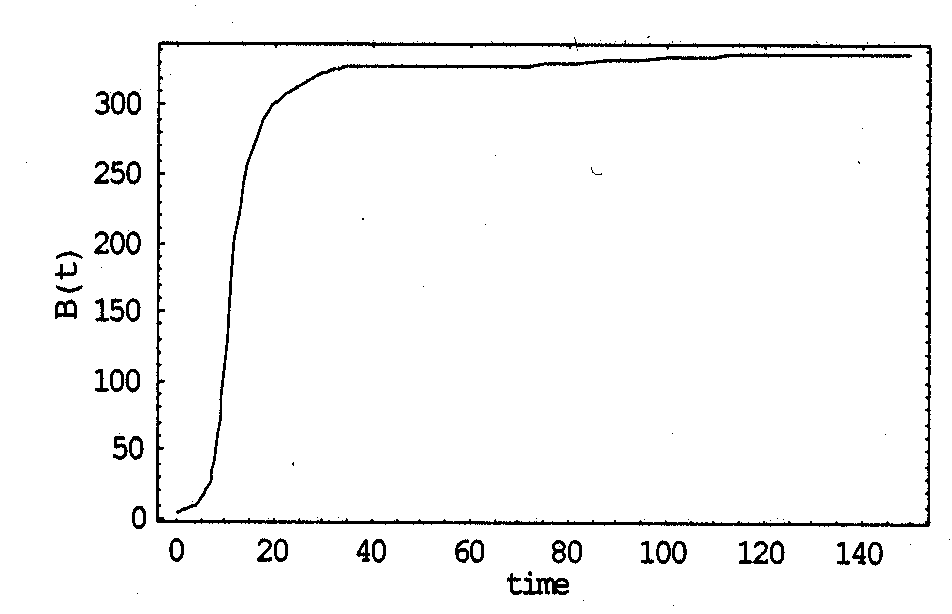
|
| Figure 3.3f. Global learning |
.gif)
|
| Figure 3.3g. Profits |
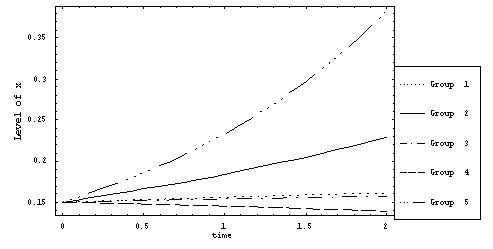
|
| Figure 3.4a. Levels of activation of practices t = 0 to 2 |
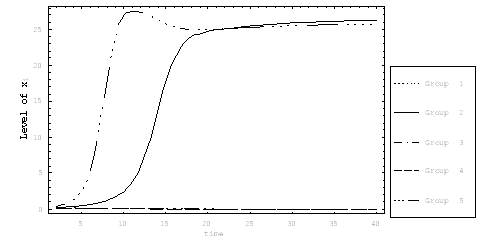
|
| Figure 3.4b. Levels of activation of practices t=2 to 40 |
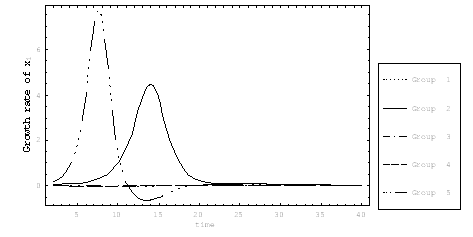
|
| Figure 3.4c. Growth rates of activation levels of practices |

|
| Figure 3.4d. Action of the hierarchy (a positive (negative) sign means that hierarchy promotes (brings down) the practices of group i) |
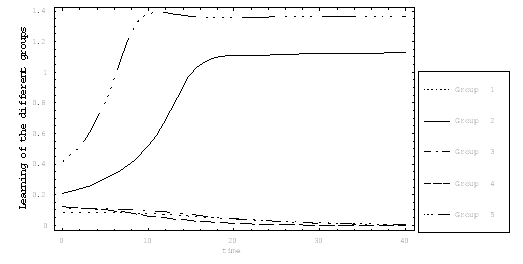
|
| Figure 3.4e. Localized learning |
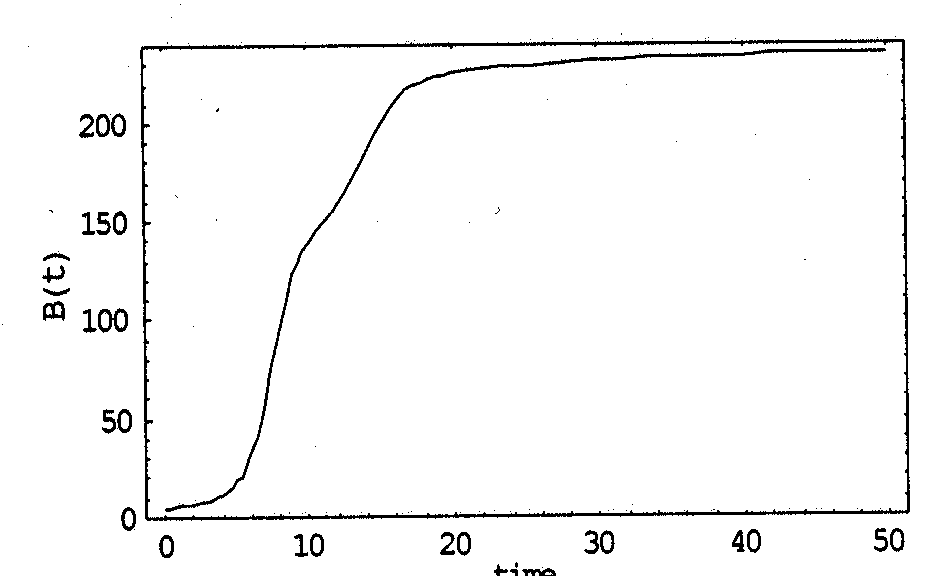
|
| Figure 3.4f. Global learning |
.gif)
|
| Figure 3.4g. Profits |
2 According to Leibenstein (1987), the motivational context lies at the heart of an important part of the organizational efficiency of firms because the relation between employers and employees (which is largely incomplete) allows scope for the interpretation of instructions in line with the social relations prevailing in a particular firm. In this context, it is clear that any attempt to channel employees’ attention and energy can be rather limited and that entrepreneurial energy may have to face the passive attitude of employees who can formally accept to respond to pressures in unforeseen or unintended ways (see also Witt (1998) for a similar discussion on this point, Foss and Foss 2003).
3 The xi(t) are not percentages, but absolute levels of diffusion (activation) of each practice on an internal specific scale established by the hierarchy. Thus, we do not assume that  .
.
4 Let us suppose that the norm r*(t), evolves according to the following motion

|
where, 0 ≤ ρ ≤ 1, and η(t) is a random variable with zero mean.
5 In the intermediate cases, the following Ω matrix applies:

|
That is to say, group 1 has zero interactions, group 2 one, group 3 two, group 4 three and group 5 four.
| Table 1: Global parameters, effort parameters and prior knowledge of groups i | |||
| β | θ | ρ | p |
| 0.75 | 2 | 0.85 | 1 |
| αi | δ i | ki0 |
0.33 | 0.05 | 0.5 |
7 This means that effort parameters and prior knowledge differ among groups. We have:
| Table 2a: Prior knowledge of groups i | ||||
| k10 | k20 | k30 | k40 | k50 |
| 0.5 | 0.75 | 0.25 | 0.5 | 0.65 |
| Table 2b: Effort parameters of groups i | ||||
| α1 | α2 | α3 | α4 | α5 |
| 0.45 | 0.33 | 0.53 | 0.73 | 0.23 |
8 Which means that the parameters are the same as in 3.1.
9 ki0 are the same as in 3.7. (cf. Table 2a and 2b)
AMIN, A and Cohendet P (2004) The architectures of knowledge. Oxford University Press, Oxford.
ARROW, K J (1994) Methodological individualism and social knowledge, Richard T. Ely Lecture. American Economic Review, May.
ARGYRIS, C (1985) Strategy, Change and Defensive Routines. Boston Pitman.
BARNARD C ( 1938) , The functions of the executive, Harvard University Press, Cambridge M. A.
BETSCH, T, Fielder K and Brinkmann J (1998) Behavioral routines in decision making : the effects of novelty in task presentation and in time pressure on routine maintenance and deviation.European Journal of Social Psychology, 28, pp. 861-876.BROWN, J S and Duguit P (2001) Organizational learning and communities of practice: towards a unified view of working learning and innovation. Organization Science, Vol. 2. N° 1, pp.40-57.
BECKER M and Lazaric N ( 2003) The influence of knowledge in the replication of routines. Economie appliquée, Tome LVI, N° 3, pp.65-94.
CAROLI E Greenan N. and Guellec D ( 2001) Organizational Change and Skill accumulation. Industrial and Corporate Change, Volume 10, N° 2, pp.481-506.
CYERT R and March J G (1963) A Behavioural Theory of the Firm. Prentice-Hall Inc.
COHEN M. D., Burkhart R., Dosi G., Egidi M., Marengo L., Warglien M. and Winter S. (1996) Routines and other recurring action patterns of organizations: contemporary research issues. Industrial and Corporate Change, Volume 5, N° 3, pp. 653-697.
COHENDET P Llerena P and Marengo L (1998), Theory of the firm in an evolutionary perspective: a critical assessment, 2nd Annual Conference of the International Society for New Institutional Economics (ISNIE), Paris, 18-19 September 1998.
COHENDET P and Llerena P (2003) Routines and incentives: the role of communities in the firm. Industrial and Corporate Change, Vol. 12, N° 1, pp.271-297.
CURRIE M and Metcalfe S (2001) , Firm routines customer switching and market selection under duoploy, Journal of Evolutionary Economics, 11: 433-456.
DOSI G Levinthal D and Marengo L (2003) Bridging contested terrain : linking incentives based and learning perspective on organizational evolution. Industrial and Corporate Change, Vol. 12, N° 1, pp.413-436.
EDMONDSON AC Bohmer R M and Pisano G (2001) Disrupted routines: effects of team learning on new technology adaptation, Administrative Science Quarterly, 46, pp.685-716.
FOSS N (2003) Selective Intervention an internal hybrids: interpretating and learning from the rise and decline of the Oticon Spaghetti Organization. Organization Science, Vol. 14, May June 2003, pp. 331-349.
FOSS K and Foss N (2003) Authority in the context of distributed knowledge, Druid Working paper.
GARAPIN A. and Hollard M (1999) Routines and incentives in group tasks. Journal of Evolutionary Economics, 9, pp. 465-486.
GARICANO L (2000) Hierarchies and the organization of knowledge in production. Journal of Political Economy, vol. 108, pp. 874-904.
GRANDORI A (1997) Governance structures, coordination mechanisms and cognitive models. Journal of Management and Governance, 1, pp. 29-42.
GRANDORI A (2001)Organizations and Economic Behavior. London, Routledge.
HANNAN M and Freeman J (1984) Structural inertia and organizational change. American Sociology Review, N° 49, pp.149-164.
GREENAN N (2003) Organisational change, technology, employment and skills: an empirical study of French manufacturing. Cambridge Journal of Economics, 27, pp. 287-316.
KAMINSKA-LABBE R and Thomas C (2003) Cognitive interactions, innovation and flexibility: what architecture for new organizational forms? Egos Conference Copenhagen.
KAUFFMAN SA (1993) The origins of order: self organization and selection in evolution. Oxford University Press, N.Y Oxford.
KNOTT AM and McKelvey B (1999) Nirvana efficient: a comparative test of residual claims and routines. Journal of Economic Behavior and Organization, Vol. 88, pp.365-383.
LAZARIC N and Mangolte, PA (1999) Routines in theory and in practice: some criticism of cognitive perspective. Rivista di Economia Contemporanea, N° 5,pp. 7-35.
LAZARIC N (2000) The role of routines, rules and habits in collective learning: some epistemological and ontological considerations. European Journal of Economic and Social Systems, N° 2, pp. 157-171.
LAZARIC N and Denis B (2001) Why and how routines change. Economies et Sociétés, vol. 6, pp. 585-611.
LEIBENSTEIN H (1987) Inside the Firm: the Inefficiencies of Hierarchy. Cambridge, Harvard University Press.
MARCH J G and Simon H (1958) Organizations. Wiley N.Y.
MARENGO L (1992) Coordination and organisational learning in the firm, Journal of Evolutionary Economics, vol. 2, pp. 313-326.
MARENGO L (1995) « Apprentissage compétences et coordination dans les organisations », In Lazaric N and Monnier JM (Eds), Coordination Économique et Apprentissage des Firmes, Economica, Paris, pp.3-22.
MASSINI S Lewin A.Y Numagami T and Pettigrew AM (2002) The evolution of organizational routines among large Western and Japanese firms Research Policy, 31 (8-9), pp.1333-1348.
MELTCALFE JS (2003).Industrial growth and the theory of retardation: precursors of an adaptive evolutionary theory of evolutionary change. Revue Economique ,Vol 54, 2, pp. 407-31.
MILES R and Snow C (1992) Causes of failure in network Organizations. California Management Review, 35, pp. 53-72
MILES R and Snow C Mathews J. A. Miles G. and Coleman J (1997) Organizing in the knowledge Age : anticipating the cellular form. Academy of Management Executive, 11, pp.7-20.
MORSING M (1998) Conflicts as the driving Force in Project Organizations. In Mette Morsing and K Eiberg (Eds), Managing the Unmanageable for a decade, Hellrup: Oticon.
NELSON R and Winter S (1982) An Evolutionary Theory of Economic Change. Cambridge Mass., Belknap Press of Harvard University Press.
POSTREL S and Rumelt R (1992) Incentives, routines and self command. Industrial and Corporate Change, Vo. 1, N° 3, pp. 397-425.
RAVESI D and Verona G (2000) Organizing the process of knowledge Integration : the benefits of structural ambiguity. Scandinavian Journal of Management, pp. 89- 99.
SAKAGUCHI H (2003) Self-organization of hierarchical structures in non locally coupled replicators models. Cond. Math. arXiv:nlin, AO/035003, May 2003.
SATO Y and Crutchfield JP (2002) Coupled replicator equations for the dynamics of learning in multi-agents systems. Cond. Math. arXiv:nlin.AO/0204057, April 2002.
SIMON H (1991) Organization and Markets. Journal of Economic Perspectives ,5, pp. 25-44.
STINCHCOMBE AL (1965) Social Structure and Organizations. In March J. G. (Ed.), Handbook of Organizations, Chicago, Rand MacNally.
WITT U (1998) Imagination and leadership: the neglected dimensions of the evolutionary theory of the firm. Journal of Economic Behaviour and Organization, Vol. 35, pp.161-177.
YOKOZAWA M. and Hara T (1999), Ecological Models, 118, 61.
Return to Contents of this issue
© Copyright Journal of Artificial Societies and Social Simulation, [2004]